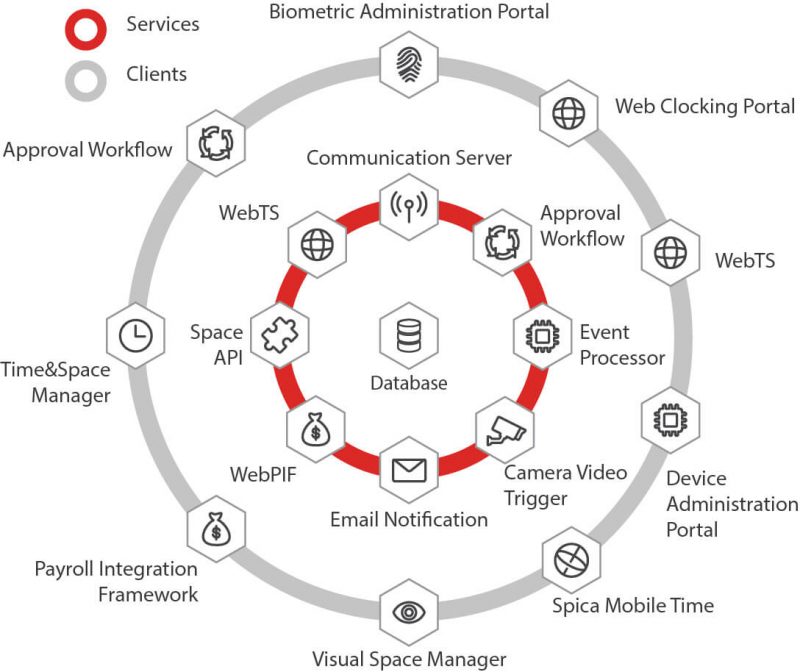Time & Space
Spica
![]()
Access control 
Every workspace needs at least some level of access control. For this reason, access control is the basic building block of every Time&Space system. For example, you can start with just a few main entrances and later develop a more complex access system for as many doors as you need.
Time & Attendance
Opening doors and recording hours on-site only scratches the surface. Your workforce is your greatest asset, and labour is your greatest cost. That is why everything counts – every day, every hour, and every minute.
For every employee, at every location, working from home or on the move.
Access control is the underlying function built into every Time&Space system. It deals with data about users, badges, access points and access rights. It also manages physically connected devices, handles alarms and collects event logs. All this provides the application framework for accommodating other higher level and add-on software modules, such as visitor management, video integration, working time clocking and time & attendance management.
Live control
Access control functionality is based on maintaining structured access profiles with programmed rules about who may enter, where and when. During normal operation, this information is automatically distributed to access controllers which are then capable of performing access control autonomously. In case of a communication dropout this will assure uninterrupted operation.
Once the communication is restored, all accumulated event logs will be automatically transferred to the system. During the normal online operation, doors can be controlled live directly from the software.
Visual monitoring
All access events, such as granted and rejected access, alarms and other signals are gathered by the system and shown in realtime. Live monitoring view provides spatial awareness by showing animated events popping-up on a floor plan.
Alarm management
The system provides powerful alarm management platform with user definable alarm categories, priority levels and automatic alarm handling workflow.
Realtime notification
Alarms and other events can be redirected to external recipients using various realtime notification methods, such as mail or text.
Event log
Event log is organized by various criteria and allows quick and deep forensic searches.
Audit log
Audit log option can be used as the ultimate solution for data integrity challenges. It is often required for larger systems because of higher security demands or privacy protection standards.
Built-in simple time calculation
Even without dedicated time & attendance module, hours worked by interns, part time workers, freelance staff or subcontractors can be tracked by using a simple working time model, such as “all weekdays from 8:00am to 6:00pm excluding Sundays”. Any number of working intervals can be configured.
Some of other advanced features:
- Local Anti-Pass-Back*
- Token based Global Anti-Pass Back*
- Toggle access mode
- Two-man rule
- Elevator control*
- Template-on-card*
* hardware-based features
Card readers
Zone Access controllers offer broad support for leading card reader brands and models, such as HID iClass series. More specific information about support for particlar brand/model is available upon request.
Biometric readers
Time&Space system offers advanced support for biometric readers from Idemia (Morpho Lite) and TBS (2D and 3D readers), both using fingerprint for identification. More details are available in separete Morpho Integration and TBS Integration brochures. Other biometric readers can be supported upon request.
Time & Space modules :

Why Time&Space should be your first choice
Access control software can be notoriously unfriendly, with myriads of difficult to understand and rarely used parameters. Conversely, time and attendance systems deal with vast amounts of data that can be intimidating even for the most capable administrators.
So what should you look for in your solution?
Modularity
Software modularity is the key to managing complex systems. Thanks to the modular structure of Time&Space, additional software modules can be added gradually, as needed.
Scalability
Time&Space has practically unlimited capacity for growth. This workforce management and security solution is used in organisations with thousands of users spread across multiple geographic locations. But it can also be deployed with equal ease in very small organisations or branch offices.
Connectivity
Time&Space’s data communication is IP-based and allows both local and privately hosted deployment. Web access is also available for all common, everyday administrative tasks. Mobile app (iOS, Android) can be used for geolocation-based
Compatibility
Time&Space does not have any special requirements for use. It performs well in most conventional PC /Windows/IP network environments and beyond, using a standard web browser. And it works equally well on the two most popular data platforms, Oracle and Microsoft SQL.
Interoperability
Time&Space is open for integration on several levels: via built-in data exports, via a separate export utility or in real-time via an IP-based signalling utility. There is also a whole module dedicated to advanced payroll integration. Finally, third party integration is available via extensive Time&Space API’s.
Industrial strength
Enterprise features such as application-level audit trails, native database authentication, support for Active Directory (AD) and other Single Sign On (SSO) schemes make Time&Space an excellent choice for even the most demanding IT environments.
User experience
Usability is a legitimate concern for any software with a powerful feature set. Time&Space meets this challenge by providing rich data visualisation, complexity hiding and optimised bulk data handling. This ensures a first-class user experience with panoramic overview and real-time control.
Localisation
We are particularly aware of the challenges of localization. Time&Space can be translated into virtually any language by the national distributor, reseller, integrator, or even the end-user. Translations are incremental so that they can follow the software versions.
- Main Features
- User experience
- Compatibility
- Connectivity
- Modularity
- Interoperability
- Industrial strength
- Localisation
- Scalability
